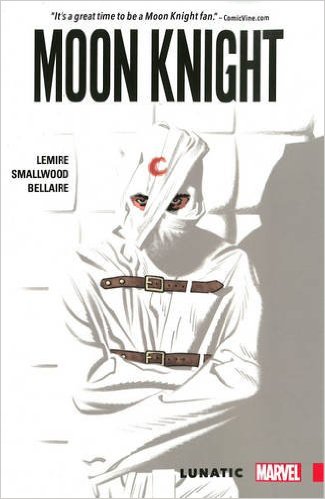Psychiatric Survivor Superhero
A review of Jeff Lemire’s Moon Knight Vol 1: Lunatic (Marvel, 2016)
By Derek Newman-Stille

Writing about mental illness tends to be challenging and most authors tend to reify disempowering tropes of mental illness, projecting people with psychiatric disabilities as villainous, problematic, dangerous, and incompetent. Jeff Lemire’s 2016 rewrite of Moon Knight challenges some of the assumptions about mental illness. Although still unclear about which psychiatric disability Moon Knight has, Lemire explores the idea of Moon Knight as a character with mental illnesses (which was first established by Alan Zelenetz and Chris Warner’s mini-series about the character). Whereas Zelenetz and Warner described him as schizophrenic because of his multiple identities (which is actually more characteristic of dissociative identity disorder), Lemire avoids specifically mentioning what the superhero’s mental illness is and complicates the idea that he is mentally ill.
First set in a psychiatric institution, Lemire’s Moon Knight encounters a fractured reality where the psychiatric institution may actually be a prison construct by Egyptian gods. Moon Knight experiences a multiplicity of possible realities and Lemire resists telling the audience whether his realities are actual visions of real worlds or whether they are manifestations of his own delusions.
This trope of “is it a manifestation of mental illness or is this person seeing the reality that is hidden” has been played with in numerous science fiction media (including the Buffy the Vampire Slayer episode “Normal Again” and the Star Trek the Next Generation episode “Frame of Mind”), asking the reader to question the nature of reality. This trope in Sci Fi normally portrays the asylum as a space for the mental breakdown of the character, encompassing the idea that asylums are places of escape from reality.
Lemire questions and criticizes the construction of the asylum as an institution, illustrating the horrors of life in an asylum and portraying the asylum as a form of prison. Lemire’s characters want to escape from the asylum, to find new possibilities in the world outside, but Moon Knight is constantly questioning and critiquing his reality and the world around him, inviting critical questions about the nature of the mind and the nature of psychiatric institutions. Lemire doesn’t provide answers about which of Moon Knight’s realities is authentic, but instead invites the reader to look at the world through multiple lenses, with multiple different possible realities. Moon Knight even shapes his own mask from a straight jacket that is draped over his face with a moon drawn onto it, and when he wears this mask, he experiences a second vision of the world, which he believes to be true.
Lemire’s exploration of multiplicity in the world is augmented by Greg Smallwood’s art, which frequently plays with multiple different visions of the world overlapping. Smallwood brings attention to the character’s vision by constantly focusing on the expression in his eyes, devoting several panels to the expressions that Moon Knight projects through his eyes. This is a comic that is focused on vision and multiple ways of seeing the world, transforming the world into a shifting, changeable plane.
To discover more about Jeff Lemire, visit http://jefflemire.blogspot.ca/



